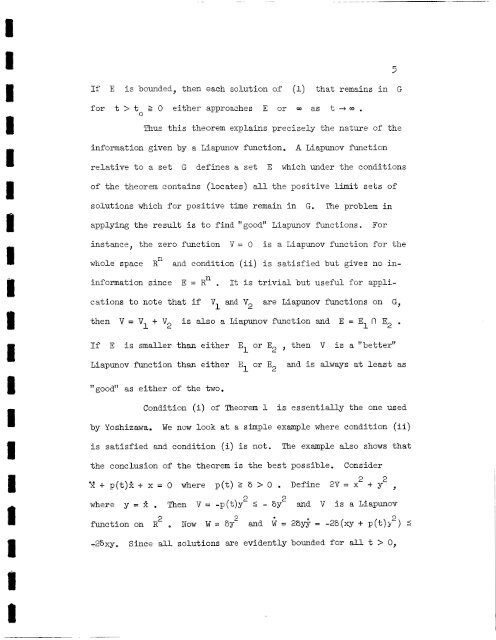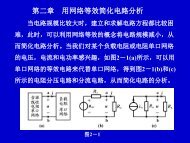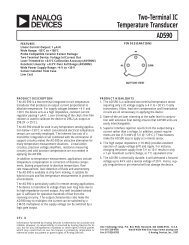AN INVARIANCE PRINCIPLE IN THE THEORY OF STABILITY
AN INVARIANCE PRINCIPLE IN THE THEORY OF STABILITY
AN INVARIANCE PRINCIPLE IN THE THEORY OF STABILITY
Create successful ePaper yourself
Turn your PDF publications into a flip-book with our unique Google optimized e-Paper software.
5<br />
If E<br />
is bounded, then<br />
each solution<br />
of<br />
(1) that remains in G<br />
for t > t 2 0 either<br />
0<br />
approaches E<br />
Thus this theorem explains<br />
or 03<br />
as t+-.<br />
precisely the nature of the<br />
information given by a Liapunov function.<br />
A Liapunov function<br />
relative to a set G defines a set E which under the conditions<br />
of the theorem contains (locates) all the positive limit sets of<br />
P<br />
!<br />
1<br />
1<br />
I<br />
I<br />
I<br />
I<br />
I<br />
solutioils which for positive time remain in<br />
applying the result is to find "good" Liapunov functions.<br />
instance, the zero function V= 0<br />
G. The problem in<br />
is a Liapunov function for tiie<br />
whole space Rn aiid condition (ii) is satisfied but gives no inn<br />
information since E = R . It is trivial but useful for appli-<br />
cations to note that if V, and V, are Liapunov functions on G,<br />
I L<br />
then V = V + V2 is also a Liapunov function and E = E ll E2 .<br />
1<br />
1<br />
If E<br />
is smaller<br />
Liapunov function<br />
"good" as either of the two.<br />
by Yoshizawa.<br />
thm either El or E2 , -then V<br />
For<br />
is a "better"<br />
than either E or E2 and is always at least as<br />
1<br />
Condition (5) of Theorem 1 is essentially the one used<br />
We now look at a simple example where condition (ii)<br />
is satisfied and condition (i) is not.<br />
the conclusion of the theorem is the best possible.<br />
The example also shows that<br />
Consider<br />
*2 + p(t)? + x = 0 where p(t) 2 6 > 0 . Define 2V = x 2 + y 2 ,<br />
2 2<br />
where y = 2 . Then V = -p(t)y 6 - 6y and V is a Liapunov<br />
2 2<br />
function on R2 Now W = 6y and = 2 6 = ~ -2S(xy + p(t)) )<br />
-26xy. Since all solutions are evidently bounded for all t > 0,









